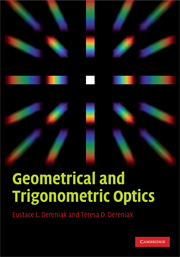Book contents
- Frontmatter
- Contents
- Preface
- 1 Light propagation
- 2 Reflections and refractions at optical surfaces
- 3 Image formation
- 4 Mirrors and prisms
- 5 Curved optical surfaces
- 6 Thin lenses
- 7 Thick lenses
- 8 Mirrors
- 9 Optical apertures
- 10 Paraxial ray tracing
- 11 Aberrations in optical systems
- 12 Real ray tracing
- Appendix A Linear prism dispersion design
- Appendix B Linear mixing model
- Appendix C Nature's optical phenomena
- Appendix D Nomenclature for equations
- Appendix E Fundamental physical constants and trigonometric identities
- Glossary
- Index
- References
3 - Image formation
Published online by Cambridge University Press: 06 July 2010
- Frontmatter
- Contents
- Preface
- 1 Light propagation
- 2 Reflections and refractions at optical surfaces
- 3 Image formation
- 4 Mirrors and prisms
- 5 Curved optical surfaces
- 6 Thin lenses
- 7 Thick lenses
- 8 Mirrors
- 9 Optical apertures
- 10 Paraxial ray tracing
- 11 Aberrations in optical systems
- 12 Real ray tracing
- Appendix A Linear prism dispersion design
- Appendix B Linear mixing model
- Appendix C Nature's optical phenomena
- Appendix D Nomenclature for equations
- Appendix E Fundamental physical constants and trigonometric identities
- Glossary
- Index
- References
Summary
Image formation has many meanings to various groups or individuals; however, in geometrical optics its definition is very clear in that it refers to the formation of a light pattern to replicate a scene. The light (radiant power) pattern formed by the optical phenomenon resembles the scene or object, and is called an image. In geometrical optics, an image-forming optical system creates a radiant pattern in two dimensions that resembles the scene that a human eye would perceive as the object. There are two general classes of images in geometrical optics: those formed by lenses and those formed by projections. In present day cameras, lenses are by far the most common means of obtaining an image.
Pinhole camera
One example of a projection system is the pinhole camera, also referred to as camera obscura (Latin for “dark chamber”), which uses a tiny pinhole to collect light without the use of a lens. Figure 3.1 illustrates this simple concept. You may recall, as a child, sitting inside a box while viewing an image projected through a pinhole onto the inside wall. The light from an object passes through a small aperture along a ray, to form an image on a surface. This image may either be projected onto a translucent screen for viewing through the camera, or onto an opaque surface for viewing in reflection.
- Type
- Chapter
- Information
- Geometrical and Trigonometric Optics , pp. 49 - 60Publisher: Cambridge University PressPrint publication year: 2008



